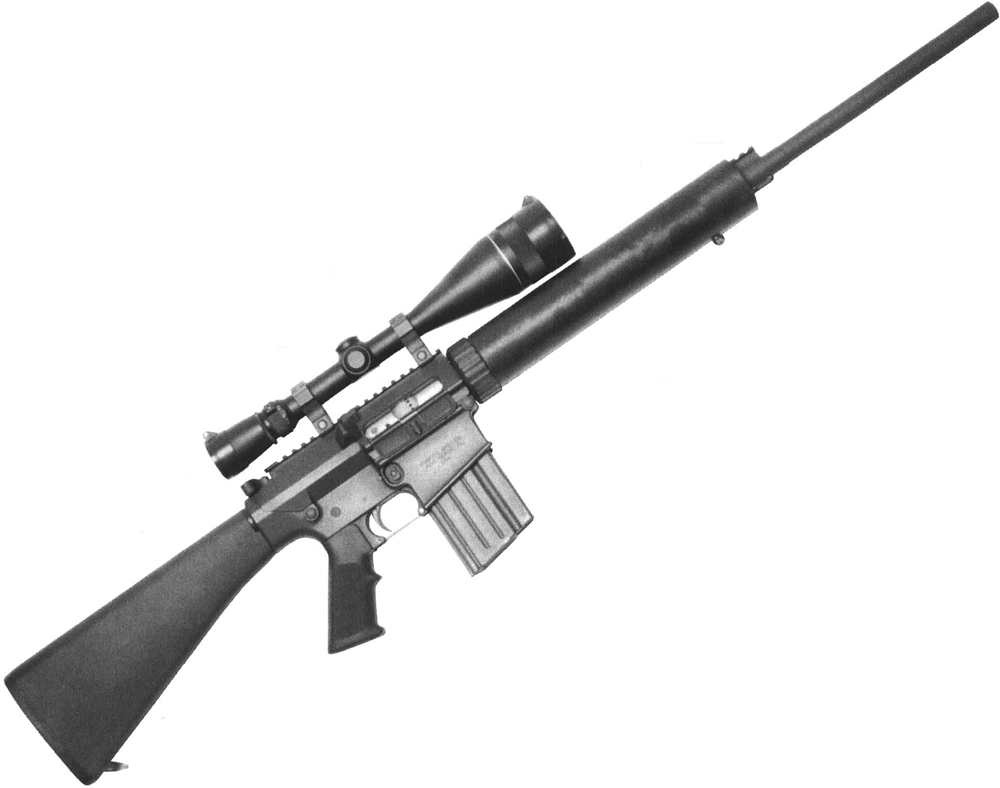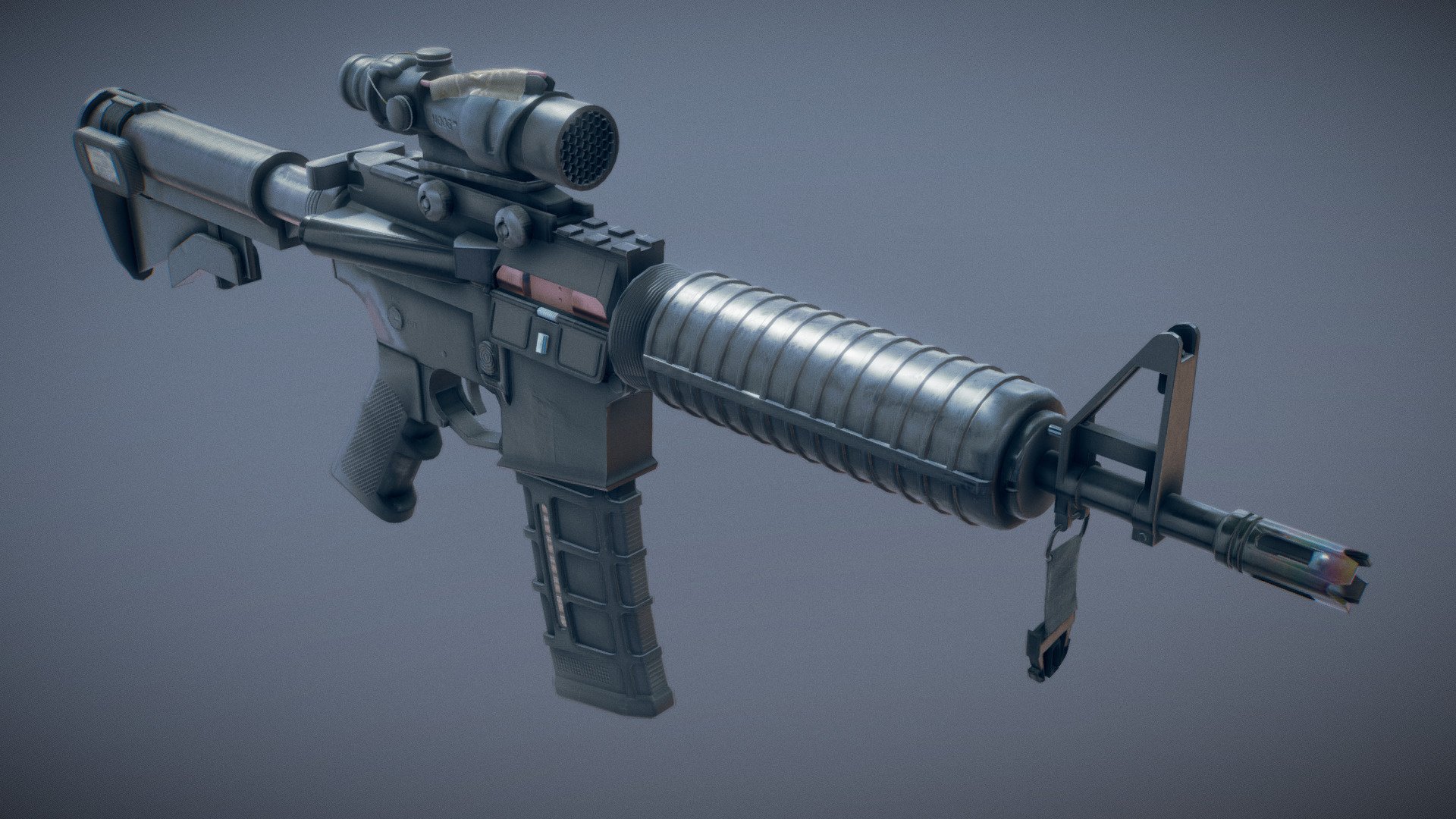M16 Style Ar - A variety of standard polymer butts were used on early AR-15/M16-series rifles. There are five basic types, although these do not seem to have received distinct maker names. Collectors today know them as Type A through Type E. These stocks were fitted to Colt Model 601 through 604 and later rifles.
The Colt 601 was fitted with Type A and Type B stocks. These are found in their unfinished state – a reddish-brown color with visible spots due to the bulk filler content in the resin – or finished with green or black. Like later types C and D, these were foam-filled for rigidity, and had a rubber butt-pad and a sling swivel. On early Type A stocks, the sling swivel could rotate fully, although these were quickly replaced by the more common split pin and are rare today.
M16 Style Ar

Type A differs from Type B primarily by the profile of the curve under the stock. While types B through E have a similar shape, the type A stock has a very short, straight horizontal section at the base of the wrist that tapers off relatively sharply before following a straight line to the toe. cargo. All successive genera studied here have a unique morphology; The initial departure from the receiver is long, and at an angle, with a shallow turn toward the toe. This difference is easy to miss unless one looks side by side (see Figure 1.2). The author speculates that the stock shift induced by the weak point at the wrist of the stock in the Type A design is an engineering decision. When the rifle is used to fire grenades, or used as an assault weapon in hand-to-hand combat, it is easy to imagine a sharp blow on the rifle shattering it.
California's Complicated History With Regulating Assault Weapons
Type A (top) and Type C (bottom) stock, the latter from Type A (Credit: Chuck Madursky/ARES) showing the margin shift at the wrist of the stock.
Primarily fitted to the Colt 602, the Type C buttstock was the last type produced using early manufacturing methods and materials, differing only in color from the Type B. Instead of a reddish-brown resin (usually painted, or sometimes dyed, black), Type C was made from a black polymer from scratch. Sometimes moles are caused by fillers. The easiest way to distinguish the Type C stock from its successors is to check the foam vent holes on the location tab (see Figure 1.3). This tab prevents rotation of the stock after it is mounted in the lower receiver. Types A and B can be distinguished by their shape (A) and material (A and B) while the foam vent hole is located on the tabs.
Type A, C, D and E stocks have locating tabs that prevent rotation of the stock once it is mounted in the lower receiver. Note the foam vent holes in Type A (left) and C (second from left) (Credit: Chuck Madursky/ARES).
The Type D buttstock followed the design of the Type C, but incorporated changes in manufacturing techniques and materials to improve durability. It was significantly heavier than earlier types, and was used in the US Air Force M16 rifles (Colt 604) and the early M16E1 rifles used by the US Army (Colt 603). Finally, the Type E stock is essentially the same as the Type D, except the butt-pad is made of hard plastic, attached by two screws, and incorporates a butt-trap to hold the cleaning box. (See Figure 1.4. ) As previously seen on the M1 'Garand' and M14 rifles, it has a fixed sling loop.
Ar15 M4a1 M16 Style Weapon Automatic Stock Photo 409095706
It's tempting to see the addition of a butt-trap as a departure from tradition—indeed, every US military rifle issued since the adoption of the Springfield Model 1892 (Craig-Jorgensen) has had a cleaning device or supply. is involved. Buttocks. However, the problem is more fundamental than that. Soldiers and Marines fighting in the Vietnam War were often issued rifles without any type of gear clearance. Combined with other startup problems, this contributed to failures in field positions. Interestingly, over time, butt-traps have been used for completely different applications. As the M16 (and semi-automatic-only AR-15) rifles were officially used in US national rifle competitions, competitors fitted their rifles with weighted front ends and, later, heavier 'match-profile' barrels. To restore the rifle's balance for long-range off-hand (standing) shots, competitors sometimes filled the rifle's butt box with actor-lead weights (see Figure 1.5).
The different weights of different types are significant. Author weighted examples are given as 285 g (10.05 oz) for Type A, 280 g (9.88 oz) for Type C, 340 g (12.00 oz) for Type D, and 375 g (13.23 oz). For type E. The significant change in weight from types A-C to types D and E may account for some reports in the literature of guns not matching the nominal weight. For example, when the author received his first AR-15 in the early 1980s, he was surprised to find that it was slightly heavier than the military manual stated. This seems to be - at least in part - the result of changes in the exterior of the buttock construction techniques and materials above. As the weapon saw increased use after its introduction, although the specifications were not extensively updated in the new manual, deficiencies were rectified by the addition of more robust furniture. The same design changes could affect the front-end assembly, which is known to have been updated and strengthened – adding to the overall weight of these updated, but still preliminary, guns.
Remember that all weapons and ammunition are dangerous. Unless you personally check, assume all guns are loaded and all ammunition is live. Unless you have expert knowledge, never assume that weapons or ammunition are safe until a subject has been tested by an expert. You must not access, handle, move, operate or transfer weapons and ammunition. Whenever you come across unexploded ordnance (UXO) or explosive remnants of war (ERW), always remember the acronym 'ARMS': A Brief History of the AR-15 Semi-Automatic Rifle in Wide Circulation for More Than Half a I - Century . In recent years, gunmen using AR-15-style weapons have carried out some of the nation's worst mass shootings.

John Jackson, co-owner of Capital City Arms Supply, in Springfield, Ill., in 2013. His shop has AR-15 rifles for sale. Semi-automatic rifles have been sold to the public since the 1960s, and the NRA estimates there are about 8 million AR-15s and related models in circulation. Hide caption Seth Perlman/AP
Hogue Ar 15/m16 Collapsible Buttstock Black Rubber
John Jackson, co-owner of Capital City Arms Supply, in Springfield, Ill., in 2013. His shop has AR-15 rifles for sale. Semi-automatic rifles have been sold to the public since the 1960s, and the NRA estimates there are about 8 million AR-15s and related models in circulation.
What was the weapon used by the gunman in the recent shooting at Marjory Stoneman Douglas High School in Florida?
For more than half a century, the AR-15 has been popular among gun owners, widely available at gun stores and, for years, even appearing in Sears catalogs.
Yet over the past decade, the AR-15 and its offshoots have been used in some of the nation's worst mass shootings. This has reignited the debate about their widespread availability.
Upgrading Your Ar 15: 8 Features You Should Consider
But, he added, "based on what happened and with these guns, we've decided that we don't want to be a part of this story."
Here's a quick history lesson on how the AR-15 became the umbrella term for semi-automatic rifles made by many gun manufacturers.
The original manufacturer of the "AR" rifle, ArmaLite, Inc. The letters from the name refer to the Armalite rifle - not "assault rifle" or "automatic rifle".
ArmaLite first developed the AR-15 as a military rifle in the late 1950s, but had little success selling it. In 1959, the company sold the design to Gould.
The History Of The Ar 15
In 1963, the US Army selected Colt to produce the automatic rifle that became standard issue for US troops in the Vietnam War. It became known as the M-16.
With that success, Gould began producing a semi-automatic version of the M-16 that was sold to law enforcement and the public, marketed as the AR-15.
Those gun manufacturers gave their names to the weapons, although the AR-15's popularity became a generic term for all types of AR-15-style rifles.
These weapons cost less than $1,000, although they can be customized and cost thousands of dollars.
Fn Fn15 M16 Semi Automatic Centerfire Rifle 5.56x45mm Nato 20 Barrel
The National Rifle Association has about eight million AR-15s and estimates
M16 ar, ar 15 m16 m4, style ar, ar 15 m16 accessories, ar style crossbow, style encore jonesboro ar, m16 style extractor, dewalt m16 style nail gun, ar 15 m16 conversion, dewalt m16 style nail gun for sale, ar 15 m16, ar style nerf gun
0 Comments